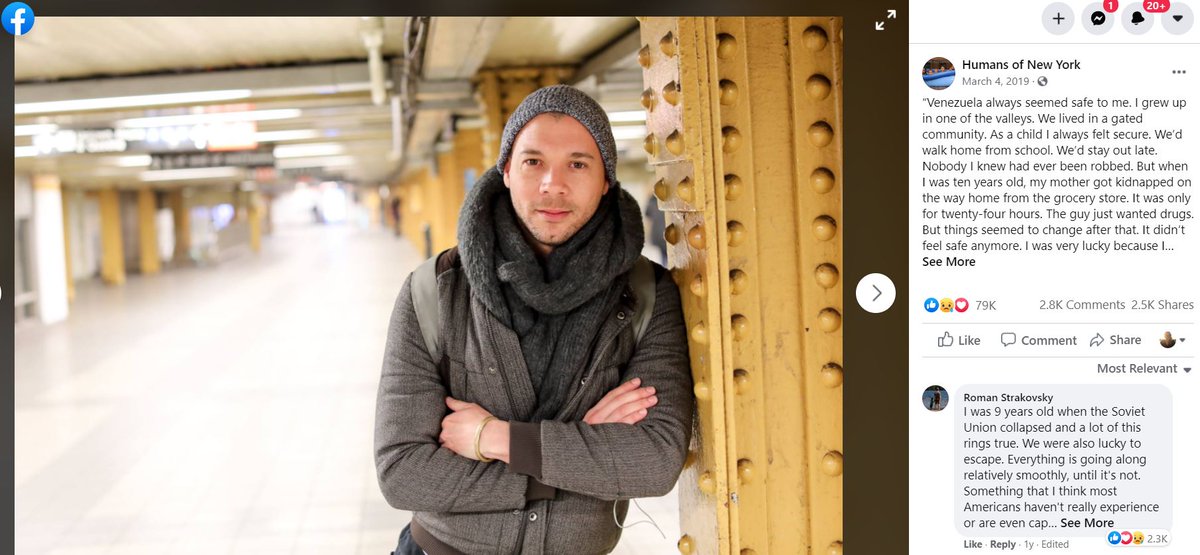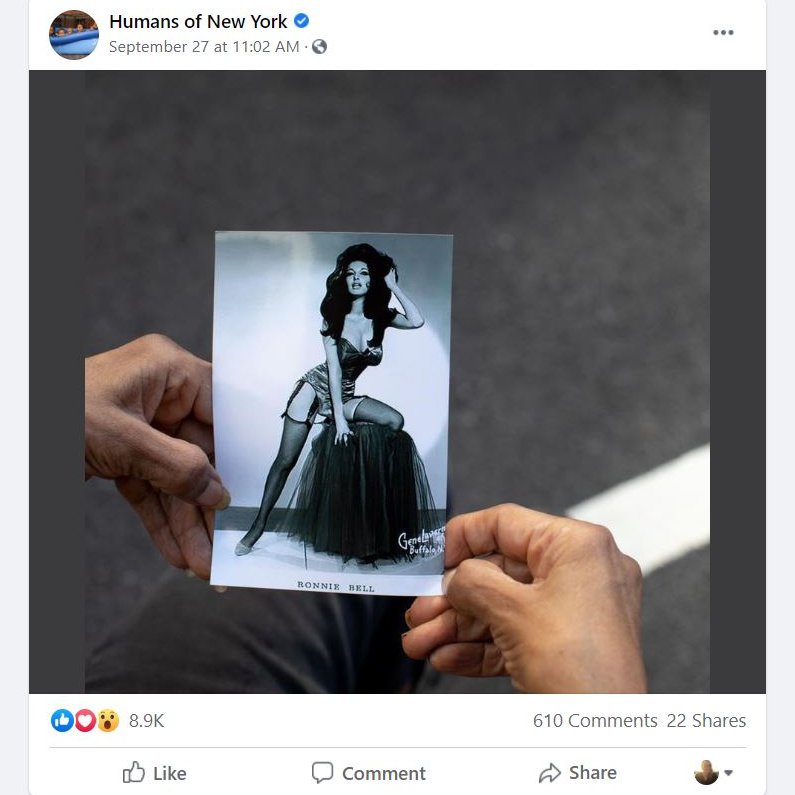For the first time in a very long time, I saw something exciting from a social media strategy on Facebook.
So here& #39;s a bunch of tweets around it so I can remember my takes later.
So here& #39;s a bunch of tweets around it so I can remember my takes later.
The content: @humansofny & #39;s Tanqueray Trust series/fundraiser.
If you missed it, HONY published 32+ posts following the story of Stephanie, who (among other things) had worked as a go-go and burlesque dancer in New York and had the stories to prove it.
https://www.humansofnewyork.com/post/630135405732347900/many-of-you-will-remember-this-young-lady">https://www.humansofnewyork.com/post/6301...
If you missed it, HONY published 32+ posts following the story of Stephanie, who (among other things) had worked as a go-go and burlesque dancer in New York and had the stories to prove it.
https://www.humansofnewyork.com/post/630135405732347900/many-of-you-will-remember-this-young-lady">https://www.humansofnewyork.com/post/6301...
Stephanie, who had danced under the name Tanqueray, had fallen on hard times.
The intent of the fundraiser was to pay Stephanie for her story, providing her funds to live on her terms.
It raised over 2.5 million dollars: https://www.gofundme.com/f/the-tanqueray-trust">https://www.gofundme.com/f/the-tan...
The intent of the fundraiser was to pay Stephanie for her story, providing her funds to live on her terms.
It raised over 2.5 million dollars: https://www.gofundme.com/f/the-tanqueray-trust">https://www.gofundme.com/f/the-tan...
Before we talk about the fundraiser itself, lets talk about Humans of New York. I, like everyone else on the internet, followed Humans of New York back in the late 2000s.
Since then I have a lot of feelings about it.
Since then I have a lot of feelings about it.
If you& #39;ve been living under a rock, you can learn more about the project here: https://www.humansofnewyork.com/about
The">https://www.humansofnewyork.com/about&quo... basic premise is this itinerant photographer wanders New York (and sometimes other places), capturing photographs of interesting people with a quote from them.
The">https://www.humansofnewyork.com/about&quo... basic premise is this itinerant photographer wanders New York (and sometimes other places), capturing photographs of interesting people with a quote from them.
Brandon Stanton, the photographer behind the project started as a side project, and now does this full time.
Here& #39;s the Patreon: https://www.patreon.com/humansofnewyork
He">https://www.patreon.com/humansofn... also has published a lot of book: https://www.amazon.com/Brandon-Stanton/e/B00ECVYQ2G?ref=sr_ntt_srch_lnk_5&qid=1601420689&sr=8-5">https://www.amazon.com/Brandon-S...
Here& #39;s the Patreon: https://www.patreon.com/humansofnewyork
He">https://www.patreon.com/humansofn... also has published a lot of book: https://www.amazon.com/Brandon-Stanton/e/B00ECVYQ2G?ref=sr_ntt_srch_lnk_5&qid=1601420689&sr=8-5">https://www.amazon.com/Brandon-S...
It& #39;s clearly a lot of work and should be reimbursed.
But there& #39;s also a lot of ethical wonkiness that he& #39;s profiting off of other people& #39;s stories (plus his considerable photography, interviewing, and social media management, and business skills).
But there& #39;s also a lot of ethical wonkiness that he& #39;s profiting off of other people& #39;s stories (plus his considerable photography, interviewing, and social media management, and business skills).
On the Tanqueray GoFundMe, readers learned Stanton was using funds from his Patreon to help with her medical bills ( https://abs.twimg.com/emoji/v2/... draggable="false" alt="👍" title="Thumbs up" aria-label="Emoji: Thumbs up">), that he was meeting with her regularly (oral history best practice and also nice), but its not clear how many more featured people fall into this category.
https://abs.twimg.com/emoji/v2/... draggable="false" alt="👍" title="Thumbs up" aria-label="Emoji: Thumbs up">), that he was meeting with her regularly (oral history best practice and also nice), but its not clear how many more featured people fall into this category.
This isn& #39;t the only time HONY has raised money on the behalf of others. In fact, Stanton states they& #39;ve raised over 12 million dollars.
The first fundraiser I was aware of was this one for a New York school: https://www.cnn.com/2015/01/24/living/feat-humans-of-new-york-harvard-fundraiser/index.html">https://www.cnn.com/2015/01/2...
The first fundraiser I was aware of was this one for a New York school: https://www.cnn.com/2015/01/24/living/feat-humans-of-new-york-harvard-fundraiser/index.html">https://www.cnn.com/2015/01/2...
I& #39;m not a philanthropy expert, but these fundraisers feel a little weird to me. To be fair, I haven& #39;t followed all of them but the early ones seemed to parachute in, raise a bunch of money, and then leave—without addressing the systemic issues.
That being said: Money now can be good. Setting the recipients up to have maximum control of how the money is spent is good.
But, what can I say, I& #39;m a systemic issue gal.
But, what can I say, I& #39;m a systemic issue gal.
The Tanqueray Trust fundraiser feels less weird to me, because of how transactional it is. We& #39;re paying her for her life story, which is a model we& #39;re familiar with.
The last bit of general wonkiness about HONY is how extremely on blast it puts its subject.
Here& #39;s a recent example, where people found the subject& #39;s parents wedding anniversary.
For most subjects at this point, they know what they& #39;re signing up for but its still a lot.
https://www.facebook.com/humansofnewyork/posts/4511821832225215?__cft__[0]=AZVK1bhhmwa-U4AaoSUoKHZz45d3bW3tVopYLtIBq0HAYewGOGROGo4F1CXUpZx-OpJfK7V7jL31u0YFG-L-vd_mb4lW1iltZ1mXwJghjv0ruXursoGAjDtkD-HpqKz4Ew9Gs2fzdXVR-YvugydZIvvvi_Yg9TPHoIy4fEtelcYhLz3GmF7Ee4gEk5wpQVXs0w4&__tn__=%2CO%2CP-R">https://www.facebook.com/humansofn...
For most subjects at this point, they know what they& #39;re signing up for but its still a lot.
https://www.facebook.com/humansofnewyork/posts/4511821832225215?__cft__[0]=AZVK1bhhmwa-U4AaoSUoKHZz45d3bW3tVopYLtIBq0HAYewGOGROGo4F1CXUpZx-OpJfK7V7jL31u0YFG-L-vd_mb4lW1iltZ1mXwJghjv0ruXursoGAjDtkD-HpqKz4Ew9Gs2fzdXVR-YvugydZIvvvi_Yg9TPHoIy4fEtelcYhLz3GmF7Ee4gEk5wpQVXs0w4&__tn__=%2CO%2CP-R">https://www.facebook.com/humansofn...
So now that I& #39;ve shared all my ~feelings~ about HONY, you can see why I was so surprised to be excited about the latest project.
The format of the Tanqueray Trust was different in that it was a 32 part series.
Each post was a standalone story, in line with the original format, only deviating slightly to include historic photos to contextualize what our heroine was talking about. https://twitter.com/humansofny/status/1308467232058388481">https://twitter.com/humansofn...
Each post was a standalone story, in line with the original format, only deviating slightly to include historic photos to contextualize what our heroine was talking about. https://twitter.com/humansofny/status/1308467232058388481">https://twitter.com/humansofn...
I did a wordcount check for one of the posts: it was 378 words (about the length of a brief blog post/article).
If each post is about that long, that would be a total of about 12,000 words.
If each post is about that long, that would be a total of about 12,000 words.
The stories were, of course, amazing.
Stanton published a few a day over the course of 9 days.
I checked in everyday for more.
The last time I remember doing that I was a college reading the New Dress a Day blog (link below for an 2010s throwback). https://www.newdressaday.com/blog ">https://www.newdressaday.com/blog"...
Stanton published a few a day over the course of 9 days.
I checked in everyday for more.
The last time I remember doing that I was a college reading the New Dress a Day blog (link below for an 2010s throwback). https://www.newdressaday.com/blog ">https://www.newdressaday.com/blog"...
The possibilities of this time of storytelling for #musesocial are really exciting.
You can tell a long story purely on social, contextualized with history. People gave money. Appointment social isn& #39;t a thing of the past!
Of course, all these things come with caveats.
You can tell a long story purely on social, contextualized with history. People gave money. Appointment social isn& #39;t a thing of the past!
Of course, all these things come with caveats.
1. Not everyone can be HONY.
He has 18 million followers and a strong place in golden-age of social nostalgia. Your organization account does not. The results aren& #39;t going to be this good.
(While I& #39;m at it, you& #39;re also not going to be StoryCorps)
He has 18 million followers and a strong place in golden-age of social nostalgia. Your organization account does not. The results aren& #39;t going to be this good.
(While I& #39;m at it, you& #39;re also not going to be StoryCorps)
2. The story has to be poppin& #39;.
People aren& #39;t going to tune back in for Joe Schmoe& #39;s story. Each aspect of Stephanie& #39;s story was fascinating, stood alone, and emotionally engaging. You also didn& #39;t know how it would end. You& #39;ve got to pick stories that do this.
People aren& #39;t going to tune back in for Joe Schmoe& #39;s story. Each aspect of Stephanie& #39;s story was fascinating, stood alone, and emotionally engaging. You also didn& #39;t know how it would end. You& #39;ve got to pick stories that do this.
3. You& #39;re not going to raise $2.6 million dollars. You& #39;re just not.
a) People are giving that much because they& #39;re giving to a person. Not an organization.
b) On the social platform and on GoFundMe there& #39;s the peer pressure of friends giving, because everyone follows HONY.
a) People are giving that much because they& #39;re giving to a person. Not an organization.
b) On the social platform and on GoFundMe there& #39;s the peer pressure of friends giving, because everyone follows HONY.
4. All platforms aren& #39;t created equal.
Compare the performance of a post on
Facebook (93K https://abs.twimg.com/emoji/v2/... draggable="false" alt="♥️" title="Herz" aria-label="Emoji: Herz">): https://www.facebook.com/humansofnewyork/posts/4819079848166077
https://abs.twimg.com/emoji/v2/... draggable="false" alt="♥️" title="Herz" aria-label="Emoji: Herz">): https://www.facebook.com/humansofnewyork/posts/4819079848166077
Twitter">https://www.facebook.com/humansofn... (760 https://abs.twimg.com/emoji/v2/... draggable="false" alt="♥️" title="Herz" aria-label="Emoji: Herz">): https://twitter.com/humansofny/status/1308146756677378048
https://abs.twimg.com/emoji/v2/... draggable="false" alt="♥️" title="Herz" aria-label="Emoji: Herz">): https://twitter.com/humansofny/status/1308146756677378048
Instagram">https://twitter.com/humansofn... (Likes hidden): https://www.instagram.com/p/CFaYWdtHMJW/ ">https://www.instagram.com/p/CFaYWdt...
Compare the performance of a post on
Facebook (93K
Twitter">https://www.facebook.com/humansofn... (760
Instagram">https://twitter.com/humansofn... (Likes hidden): https://www.instagram.com/p/CFaYWdtHMJW/ ">https://www.instagram.com/p/CFaYWdt...
4 continued. All platforms aren& #39;t created equal.
Part of the magic of HONY is a striking visual coupled by a great quote. It started on FB and works best there.
Twitter has never worked well for HONY, compressing all the info into one 1200 by 600 graphic.
Part of the magic of HONY is a striking visual coupled by a great quote. It started on FB and works best there.
Twitter has never worked well for HONY, compressing all the info into one 1200 by 600 graphic.
4b. Facebook is still garbage.
In addition to contributing to the downfall of democracy, Facebook& #39;s interface sucks. When you upload pictures with a post they also appear separately, out of context on timelines.
In addition to contributing to the downfall of democracy, Facebook& #39;s interface sucks. When you upload pictures with a post they also appear separately, out of context on timelines.
5. Have a schedule and stick to it.
Stanton posted three times a day, two hours after the previous post. After the first two days, you knew how to plan. It spread the excitement over several days, and didn& #39;t spend all the dynamite posts on one day.
Stanton posted three times a day, two hours after the previous post. After the first two days, you knew how to plan. It spread the excitement over several days, and didn& #39;t spend all the dynamite posts on one day.
5 continued. Have a schedule and stick to it.
But note, he went all in. He didn& #39;t interrupt it for other posts, not matter what was happening in the world. He stayed on message.
But note, he went all in. He didn& #39;t interrupt it for other posts, not matter what was happening in the world. He stayed on message.
6. Invest in the story you& #39;re telling.
Part of what& #39;s exciting about the was the Tanqueray Trust story is told, especially for museums, is the historical context in the pictures.
Of the non-personal pictures, most of the rest are Getty.
Part of what& #39;s exciting about the was the Tanqueray Trust story is told, especially for museums, is the historical context in the pictures.
Of the non-personal pictures, most of the rest are Getty.
6 continued. Invest in the story you& #39;re telling.
With Stanton being a photographer and the consistent credits, I& #39;m going to assume that he properly licensed the photos.
Image rights are expensive, but a) follow the law, and b) don& #39;t shoot yourself in your storytelling foot.
With Stanton being a photographer and the consistent credits, I& #39;m going to assume that he properly licensed the photos.
Image rights are expensive, but a) follow the law, and b) don& #39;t shoot yourself in your storytelling foot.
7. Your organization *might* not need a podcast.
My favorite part of this story (other than like a woman getting money to help her live in dignity) is that they were thinking about doing a podcast then DIDN& #39;T DO IT.
My favorite part of this story (other than like a woman getting money to help her live in dignity) is that they were thinking about doing a podcast then DIDN& #39;T DO IT.
7 cont& #39;d. Your org might not need a podcast.
Good podcasts are lots of work and investment. There& #39;s equipment to buy. A production team to work with. Then you have to build a following. It can be powerful, but this might not be something you& #39;re overstretched staff can do.
Good podcasts are lots of work and investment. There& #39;s equipment to buy. A production team to work with. Then you have to build a following. It can be powerful, but this might not be something you& #39;re overstretched staff can do.
7 cont& #39;d. Your org might not need a podcast.
Invest in the platforms and audiences you have.
Lean into the platform that matches the method of storytelling. Is it highly visual? FB and IG are good. Really audio driven? Then maybe a podcast? (Or a collab with an existing one.)
Invest in the platforms and audiences you have.
Lean into the platform that matches the method of storytelling. Is it highly visual? FB and IG are good. Really audio driven? Then maybe a podcast? (Or a collab with an existing one.)

 Read on Twitter
Read on Twitter




